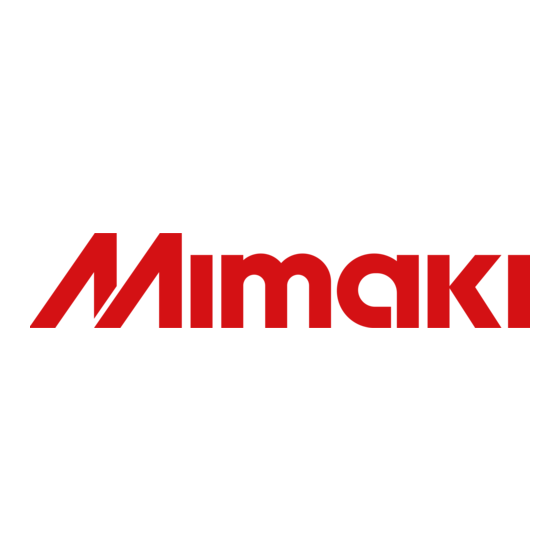
Table of Contents
Advertisement
Quick Links
Requests for Care and Maintenance
This machine is a precision machine equipped with extremely fine mechanisms. Especially, the nozzle sur-
face of the heads from which the ink is discharged is affected even by a slightest attachment of dust or paper
powder and the proper printing results could not be obtained. With a view to using this machine in a better
condition, we would like to recommend performing the following care and maintenance on daily basis.
1. When to care
When to care
Once a day
(at the end of the daily work)
Once a week
(at the end of the work on
weekend)
Replace or clean when it is dirty
When the Machine Is Not Used
for a Long Time
Tools required for maintenance
• Cleaning stick (SPC-0527)
• Cleaning Liquid Bottle Kit A29 for sublimation dye ink (SPC-0137)
• Cotton swab
• Gloves
• Soft fabric
Inkjet printer JV300-130A/160A
Surroundings of the heads
Capping station
Wiper
Media press
Media sensor
Cleaning the Platen
Exterior
Waste ink tank
Ink Discharge Passage
Cleaning the pinch roller
Perform "Storage Wash"
What to care
1
Reference Page
P.2
P.3
P.4
P.5
P.5
P.6
P.6
P.6
P.7
P.8
P.10
Advertisement
Table of Contents

Subscribe to Our Youtube Channel
Summary of Contents for MIMAKI JV300-130A
- Page 1 Inkjet printer JV300-130A/160A Requests for Care and Maintenance This machine is a precision machine equipped with extremely fine mechanisms. Especially, the nozzle sur- face of the heads from which the ink is discharged is affected even by a slightest attachment of dust or paper powder and the proper printing results could not be obtained.
-
Page 2: Daily Care
2. Daily care • When possible, use the cleaning stick (SPC-0527) for cleaning around the head/ capping station/ wiper. Using the other cotton bud may attach lint, then it may damage the machine. • Be sure to perform maintenance for the ink cap and the wiper of capping station every day. If you leave it dirty, dirt may adhere to the nozzle surface, or, dust and dry ink may be rubbed against the nozzle. - Page 3 (2) Capping Station ("Cleaning around the wiper" Chapter 4 of the Operation Manual) The surrounding area of the cap is also liable to be stained by the dust and ink. It is recommended to clean the head frequently using the cleaning liquid for maintenance suitable for the ink used to avoid the stains on the head.
- Page 4 (3) Wiper ("Cleaning around the wiper” Chapter 4 of the Operation Manual) On the wiper, the ink, dust and paper powder are liable to accumulate. Check the state of the wiper and if it is stained, clean it. • Cleaning Liquid Bottle Kit A29 for sublimation dye ink (SPC-0137) Move the carriage and open the right maintenance cover.
- Page 5 (4) Media press (“Cleaning the Media Press” Chapter 4 of the Operation Manual) When the cut dust of the media and other dusts accumulate between the media holder and the platen, it could cause the risks that the transfer of the media could not be performed properly or such dusts stick to the noz- zles and this could interfere the proper printings.
-
Page 6: Periodically Care (Once A Week)
3. Periodically care (Once a week) Users are advised to perform the maintenance works described below once a week so that the printer will keep its high performance and accuracy over an extended period of its life. (1) Platen (“Cleaning the Platen” Chapter 4 of the Operation Manual) Platen is a place where dusts, paper powder, and ink are liable to accumulate. - Page 7 (4) Ink Discharge Passage (“Washing the Ink Discharge Passage” Chapter 4 of the Oper- ation Manual) Wash the ink discharge passage (DISWAY WASH) regularly(about once a week) to prevent the head nozzles from clogging due to ink coagulation inside the passage. •...
- Page 8 4. Replace or clean when it is dirty (1) Cleaning the pinch roller Cleaning the pinch roller (SPA-0247) when it is dirty. Also replace the pinch roller when it is worn or dirty. Raise the clamp lever to keep the pinch roller lifted Remove the O-ring retaining the pinch roller •...
-
Page 9: Storage Of Media
5. Storage of media Media should be stored in the little dust area, and not in direct sunlight. Avoid storing the media in the area with high temperature and high humidity. 6. Storage of ink bottle Be careful of the followings to store. •... -
Page 10: Recovery Method Of Defective Nozzle Discharge
8. Recovery method of defective nozzle discharge When this printer has not been used for an extended period of time, or depending on the environmental tem- perature, the discharge at the nozzles could become unstable. In such a case, the following methods may be taken to recover the status of the nozzles. -
Page 11: Safety Precautions
11. Safety Precautions CAUTION Make sure to wear the attached goggles and gloves. The ink, if mixed with water or alcohol, generates condensed substances. Pay attention not to deposit water or alcohol to the nozzle surface, surrounding area of the heads, caps and wipers. To secure the stability of the ink discharge, when the printer is not used (output) for an extended period of time, it could become necessary to discharge periodically a small amount of ink (flushing), depending on the kinds of the ink. - Page 12 You can also download the latest manual from our website. 2014 MIMAKI ENGINEERING CO., LTD. D202762-10-22092014 FW :1.30...












Need help?
Do you have a question about the JV300-130A and is the answer not in the manual?
Questions and answers